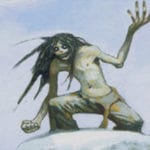 Technology
Technology  Technology
Technology  Humans
Humans 10 Everyday Human Behaviors That Are Actually Survival Instincts
 Animals
Animals 10 Animals That Humiliated and Harmed Historical Leaders
 History
History 10 Most Influential Protests in Modern History
 Creepy
Creepy 10 More Representations of Death from Myth, Legend, and Folktale
 Technology
Technology 10 Scientific Breakthroughs of 2025 That’ll Change Everything
 Our World
Our World 10 Ways Icelandic Culture Makes Other Countries Look Boring
 Misconceptions
Misconceptions 10 Common Misconceptions About the Victorian Era
 Mysteries
Mysteries 10 Strange Unexplained Mysteries of 2025
 Miscellaneous
Miscellaneous 10 of History’s Most Bell-Ringing Finishing Moves
 Technology
Technology Top 10 Everyday Tech Buzzwords That Hide a Darker Past
 Humans
Humans 10 Everyday Human Behaviors That Are Actually Survival Instincts
 Animals
Animals 10 Animals That Humiliated and Harmed Historical Leaders
Who's Behind Listverse?

Jamie Frater
Head Editor
Jamie founded Listverse due to an insatiable desire to share fascinating, obscure, and bizarre facts. He has been a guest speaker on numerous national radio and television stations and is a five time published author.
More About Us History
History 10 Most Influential Protests in Modern History
 Creepy
Creepy 10 More Representations of Death from Myth, Legend, and Folktale
 Technology
Technology 10 Scientific Breakthroughs of 2025 That’ll Change Everything
 Our World
Our World 10 Ways Icelandic Culture Makes Other Countries Look Boring
 Misconceptions
Misconceptions 10 Common Misconceptions About the Victorian Era
 Mysteries
Mysteries 10 Strange Unexplained Mysteries of 2025
 Miscellaneous
Miscellaneous 10 of History’s Most Bell-Ringing Finishing Moves
10 Weird Beings From Slavic Mythology And Folklore
Greek and Roman mythologies are so common in Western culture that most people have never heard of the polytheistic pantheon of other cultures. One of the least well-known is the Slavic pantheon of gods, spirits, and heroes that persisted before and after Christian missionaries converted the region.
Slavic mythology has two key differences from the well-known Greek and Roman mythologies. First, many of the spirits are still part of common images and folktales among Slavic people. Secondly, the old Slavic pantheon of gods is not well documented, so scholars have attempted to recreate the information based on secondary documents. Still, the pantheon is fascinating and worth knowing.
10 Baba Yaga

Among mythologies, Baba Yaga is unique to the Slavic people. Many other Slavic gods and creatures have equivalents in Roman or Greek mythology, but Baba Yaga does not.
At first glance, Baba Yaga seems like various witches in European folklore. She appears as an old woman and has an extremely long nose and spindly legs. When travelers meet her, she gives them a blessing or a curse depending on her mood.
But Baba Yaga also has a variety of features that are uncommon. She lives in a hut with chicken legs on the bottom that allow it to move around. When Baba Yaga is outside her hut, she travels in a mortar with a pestle.
Like traditional witches, Baba Yaga carries a broom, but she uses it to sweep away the tracks that she makes. In certain traditions, Baba Yaga appears as three sisters, each with the same name.
Nobody knows exactly when Baba Yaga stories began. Unlike many other Slavic mythological beings, Baba Yaga folklore was still going strong in the 20th century. Part of the staying power of Baba Yaga is that her morality is hard to pin down. In hopes of receiving great wisdom, travelers trekked from far and wide to talk with her.
9 Bannik
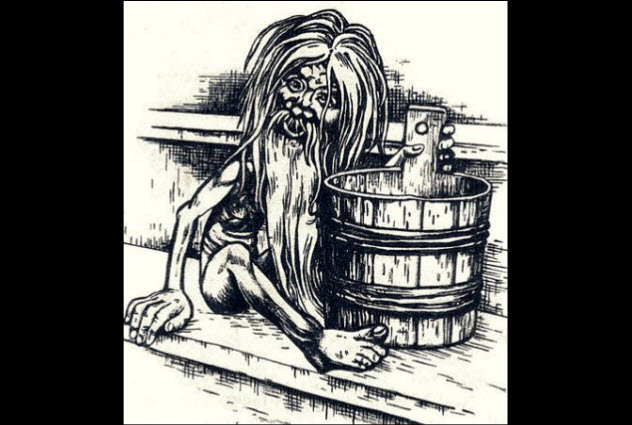
The banya steam bath is an important part of Eastern European life, especially in countries like Russia and Ukraine. These steam baths are especially frequented in the winter and are supposed to have a variety of medicinal benefits.
Ancient Russian records often mention the banya. In fact, it was even used for childbirth. Due to the social and cultural influence of the banya, Slavic mythologies included a banya spirit known as Bannik.
Bannik was a mischievous spirit who rarely did good for anyone. His appearance was that of an old man with long claws. Whenever bathing occurred in the banya, occupants of the banya always left on the third or fourth session to give Bannik privacy. They also regularly thanked the spirit and left him offerings of soap.
Tales of Bannik said that he had the power to predict the future. When asked a question, Bannik would softly touch the back of the questioner if the future was good and flay his back if the future was bad. When Bannik got angry, he would claw off the skin of those who annoyed him.
As the banya was usually the place of Russian childbirth, folk traditions included ways to keep Bannik from interfering with the delivery. When a woman gave birth in the banya, part of the midwife’s job was to keep Bannik away.
According to legend, Bannik ate or flayed children in the banya. A midwife would dip stones in water and throw them into the corner of the banya to distract Bannik.
The banya was also important in wedding ceremonies. Before a couple sat in the steam bath together, wedding guests threw rocks and pottery at the walls from the outside to scare away Bannik and keep the wedding couple safe.
8 Zduhac
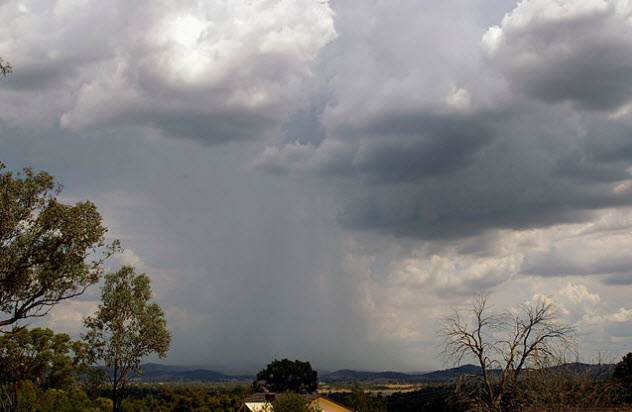
In pre-Christian Slavic lands, witchcraft was an important part of the culture. Various witches and wizards were employed to protect people and lands from marauding spirits. Chief among the protectors of the ancient Slavs were the zduhacs. A zduhac was a man who used supernatural powers to protect his village and attack other villages.
Scholars are unsure about the origin of the zduhac tradition, but it seems to be a corrupted form of the Eurasian shamans. The shaman tradition most likely traveled west with trans-Siberian Finno-Ugric and Uralic ethnic groups.
Ancient Slavs were already superstitious people, and the idea of a supernatural protector fit in well with their belief system. Each village had a zduhac that fought the zduhac from another village. Often, these fights occurred in the clouds.
Sometimes, the two zduhacs transformed into animals and fought that way. If they were not shape-shifting, zduhacs had a variety of weapons, including sticks that were charred at both ends and used as magical talismans.
Tradition varies about how the zduhac got his power. Some traditions state that it came from special clothing, although others assume that the zduhac made a pact with a demon to get his powers.
The tradition of the zduhac survived well into the modern era of Slavic culture, especially in Montenegro. Although zduhacs were no longer defenders of villages, common folklore stated that different influential men were the modern zduhacs. These include the Montenegrin general Marko Miljanov and various Montenegrin spiritual leaders.
7 Domovoi
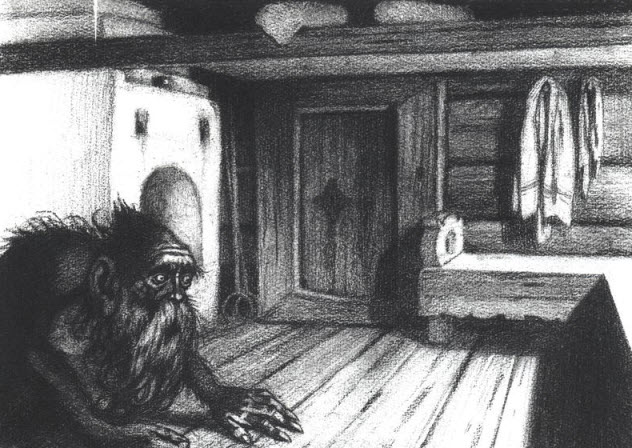
The domovoi are household spirits that were common in pre-Christian Slavic myths. Although Christian missionaries were mostly successful in removing the old pagan ideas from their new Slavic converts, domovoi traditions remained intact throughout the centuries.
Domovoi were household protectors that were generally seen as kind spirits. Most depictions of domovoi show small, bearded, masculine creatures that are similar to Western European household spirits such as hobgoblins.
To complete his chores and protect the house, a domovoi often took the form of the head of the household. Many legends state that a domovoi was seen working in the yard in the shape of the head of the household while the real person was fast asleep in bed. Rarely, a domovoi took the shape of a cat or dog.
If the household that he was protecting was rude or unclean, the domovoi harassed the family in ways that were similar to a poltergeist, pulling small pranks until the family cleaned up their act.
A domovoi could also act as an oracle. If one was seen dancing and laughing, good fortune would come. If a domovoi rubbed the bristles of a comb, a wedding would happen soon. But if he extinguished candles, misfortune would fall upon the household.
The legend of the domovoi survived through the 20th century, making occasional appearances in Russian art.
6 Kikimora
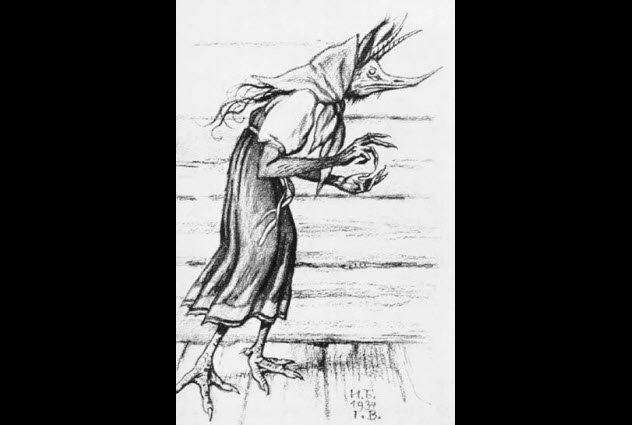
The opposite of the domovoi was the kikimora, an evil household spirit in Slavic mythology that was especially prominent in Polish and Russian stories.
The kikimora was a witch or the spirit of the deceased who lived in the house and was usually seen as a source of evil. She lived behind the stove or in the cellar of the house and made noises to get food. Most of the time, the kikimora terrorized the family, especially if the house was not in order.
According to Slavic traditions, the kikimora entered a house through the keyhole and attempted to strangle people in their sleep. The kikimora normally sat on the sleeping person and strangled them. Ancient Russians assumed that the kikimora was the cause of sleep paralysis.
To repel the kikimora, residents had to say elaborate prayers or place brooms near the door. Polish traditions held that children should make the sign of the cross on their pillows to repel the kikimora.
Although encounters with a kikimora could be life-threatening, the kikimora was usually more of an annoyance and just attempted to scare residents of the house.
When the house was dirty or not in order, the kikimora whistled and broke dishes. But if she liked the house, she helped to take care of the chickens and other household chores.
Since the kikimora is such a big part of Slavic mythology, she is a common character in stories and music. A recently discovered spider was named after her.
5 Mokosh
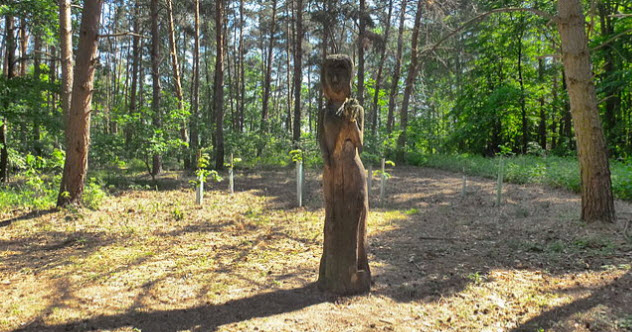
Before the Christian era, Mokosh was the Slavic god of fertility that was common in Russian and Eastern Polish mythologies. She was traditionally associated as a handmaiden to Mat Zemlya, the god of nature, but worship of Mokosh gradually overtook that of Mat Zemlya.
Unlike Mat Zemlya, Mokosh worship survived well into the 19th century, and she is still a popular figure in modern-day Russia. Although Mokosh seemed to originate in Finno-Ugric tribes, she gradually became widespread in Slavic lands. This accounted for the Finnish etymology of her name.
Mokosh was depicted as a wanderer who was responsible for spinning, childbirth, and protecting women. Believers saw her as the giver of life in the form of children and weather. Tradition stated that rain was the breast milk of Mokosh and gave life to the land.
Worship of Mokosh included fertility rituals and praying to breast-shaped boulders. The Slavic people reserved the last Friday of October to worship her. Mokosh festivals included dancing in two circles, with the outer circle representing life and the inner circle representing death.
Christian missionaries attempted to stamp out all Mokosh cults by replacing her with Mother Mary. However, the missionaries were not entirely successful because Mokosh is still an important figure in Slavic mythology.
4 Radegast
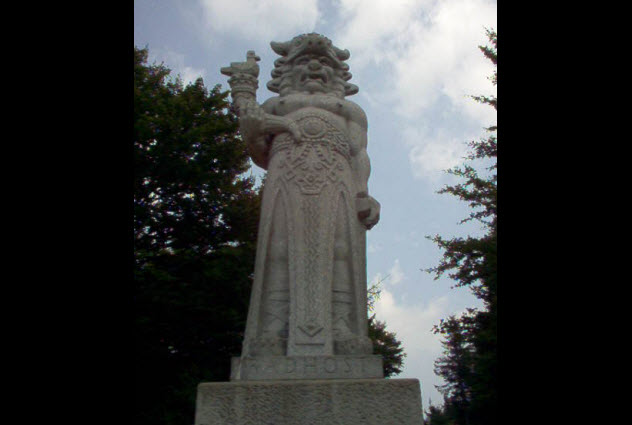
Radegast is one of the oldest gods in Slavic mythology and one that has been mostly reconstructed from secondary documents. His name comes from two old Slavic words meaning “dear guest.”
From that etymology, it is assumed that Radegast was worshiped as a god of banquets and houseguests. It is believed that a ceremonial invitation was given to him by people holding a feast.
When he arrived, tradition stated that Radegast wore black armor and was armed with a sphere. Researchers believe that he was an important god for leaders and town councils.
Usually, the person appointed to lead a town council was called Radegast for the duration of the meeting. As a result, Radegast became central to the political and economic lives of the Slavic people.
Piecing together the mythology behind Radegast is difficult because Christian missionaries made a special effort to stamp out worship of him. Mt. Radhost in the modern-day Czech Republic had a large statue of Radegast, but the Christian missionaries Cyril and Methodius destroyed it.
Legend also states that Slavic pagans sacrificed Christian bishop Johannes Scotus to Radegast in 1066. During the era of Christianization, these actions made the missionaries focus on ending Radegast worship and many of the primary documents were lost.
In modern times, author J.R.R. Tolkien named one of his wizards Radegast, ensuring that the legend survives today.
3 Chernobog
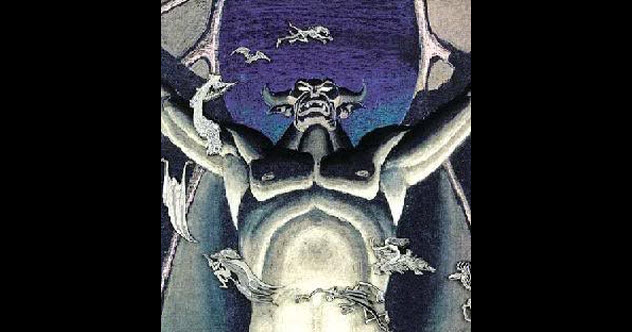
Of all the Slavic polytheistic deities, Chernobog is the most well-known to the general population. He appeared in Disney’s Fantasia and was also important in Neil Gaiman’s popular novel American Gods, which will soon be adapted for TV.
Oddly enough, Chernobog was one of the more theoretical gods of the Slavic pantheon. It is nearly impossible to find source material for him, and most secondary material comes from Christian sources.
The first known record of Chernobog came from the writings of Father Helmold, a German priest, in the 12th century. According to Helmold, the Slavic people engaged in rituals surrounding Chernobog, including passing bowls around a circle and whispering prayers to protect themselves from him. From Helmold’s writings, scholars have learned that Chernobog was the personification of evil. He wore a dark cloak and appeared to be a devil.
It is not clear how widespread this myth was in ancient Russia, but it seems to have been prominent in northern Russia. The role of Chernobog overlapped with the evil god Veles of older mythology.
Evidence of Chernobog is also seen in common Slavic phrases. The phrase do zla boga literally means “go to the evil god” and is a curse. Other instances of the term “evil god” are used as an intensifier for adjectives. This structure in Slavic languages supports the idea that early Slav phrases used Chernobog as a conceptual influence.
2 Veles
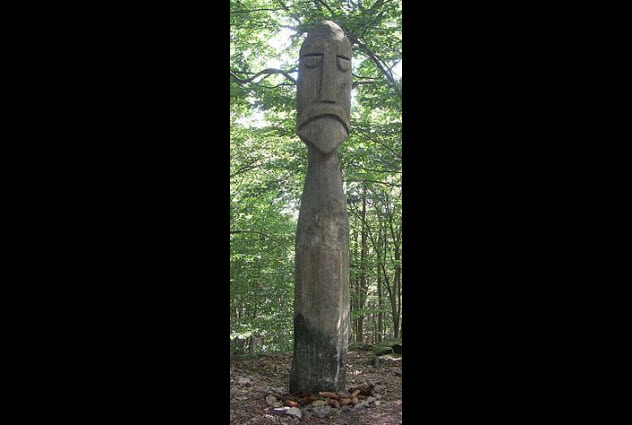
Most ancient mythologies have one god that represents all evil and one supreme god that represents all good. Veles is the ancient Slavic god that is associated with evil. He is in constant conflict with Perun, his good brother that was the thunder god.
Scholars have found a variety of sources confirming the influence of Veles over the ancient Slavs. In Slavic myths, Veles represented a supernatural force in charge of the earth, the waters, and the underworld. He is also associated with magic and cattle.
Veles is said to have fought with and been defeated by Perun. Although no primary source for this myth exists, scholars have reconstructed it through analysis of Slavic folk songs, secondary records, and comparisons with other Indo-European mythologies.
The Slavs believed that Veles and Perun were in constant combat, with Perun protecting the human world from Veles. Still, temples were built and dedicated to Veles, mostly in low geographical points such as valleys. He was also associated with musicians and wealth.
As ancient Slavs did not usually have a clear dichotomy between good and evil, Veles was not seen as being completely bad. However, when the Christian missionaries attempted to end Slavic paganism, they taught that Veles was the Christian Devil. Thus, the depiction of Veles gradually merged with the characteristics of Satan as described in the Bible.
1 Perun
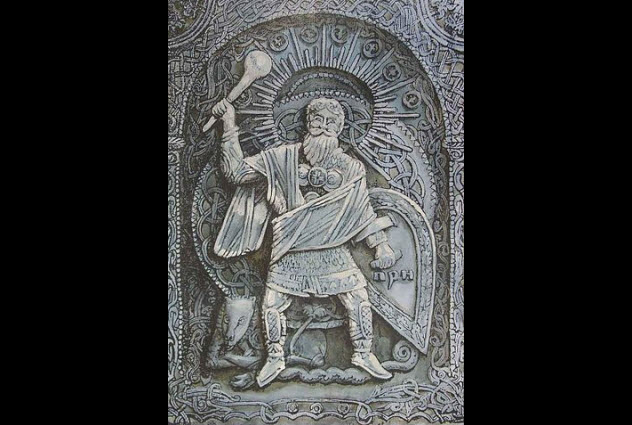
Although some scholars disagree, the general consensus is that the ancient Slavs considered Perun, the thunder god, to be the supreme god of humanity. Perun appears the most often in old Slavic texts, and symbols of him are common in Slavic artifacts. For the ancient Slavs, Perun was the most important god in their pantheon.
Perun was the god of war and thunder. He rode a chariot and wielded several mythical weapons. The most important was his axe. He threw it at the wicked, and it always returned to his hand. Perun also fought with stone and metal weapons and fire arrows.
When Perun wanted to send the ultimate destruction upon his enemies, he used magical golden apples. These apples were talismans of ultimate devastation. Due to his epic nature, Perun was always depicted as a muscular man with a beard made of bronze.
In the mythology, Perun fought with Veles over the human race and always won, banishing Veles to the underworld. As such, Perun was considered to be the most important god.
In 980, Prince Vladimir the Great erected a statue of Perun in front of his palace. As Russian power spread, the worship of Perun became prominent among the Eastern Europeans and spread throughout the Slavic culture.
When the Christian missionaries first came to Russia, they attempted to dissuade the Slavs from pagan worship. In the East, missionaries taught that Perun was the prophet Elijah and made him a patron saint.
Western missionaries replaced Perun with St. Michael the Archangel. Over time, the characteristics of Perun became associated with the Christian monotheistic God. Still, the worship of Perun survived throughout the Christian era, and worshipers still hold feasts on July 20 in honor of the thunder god.
Zachery Brasier attempts to write interesting things.

